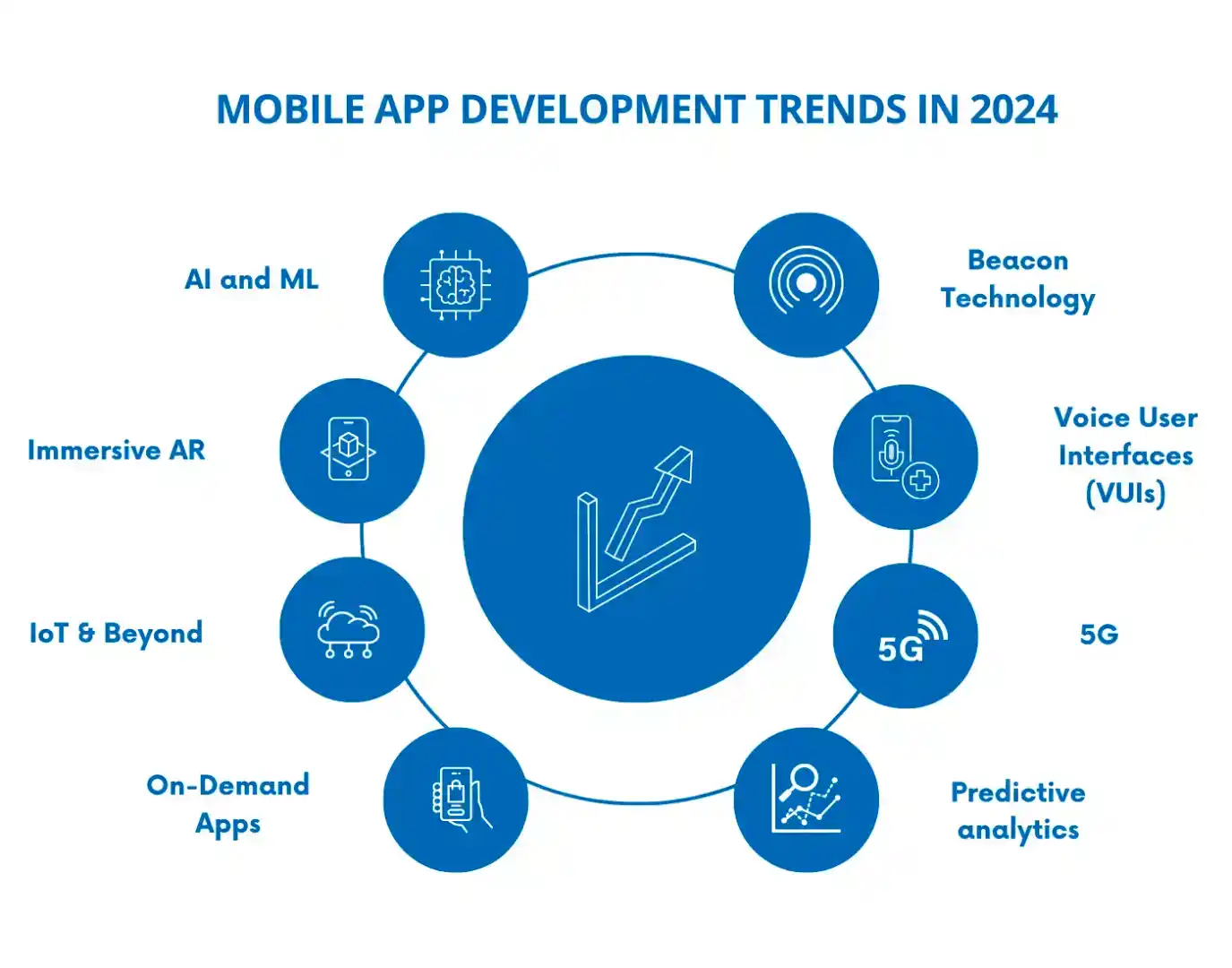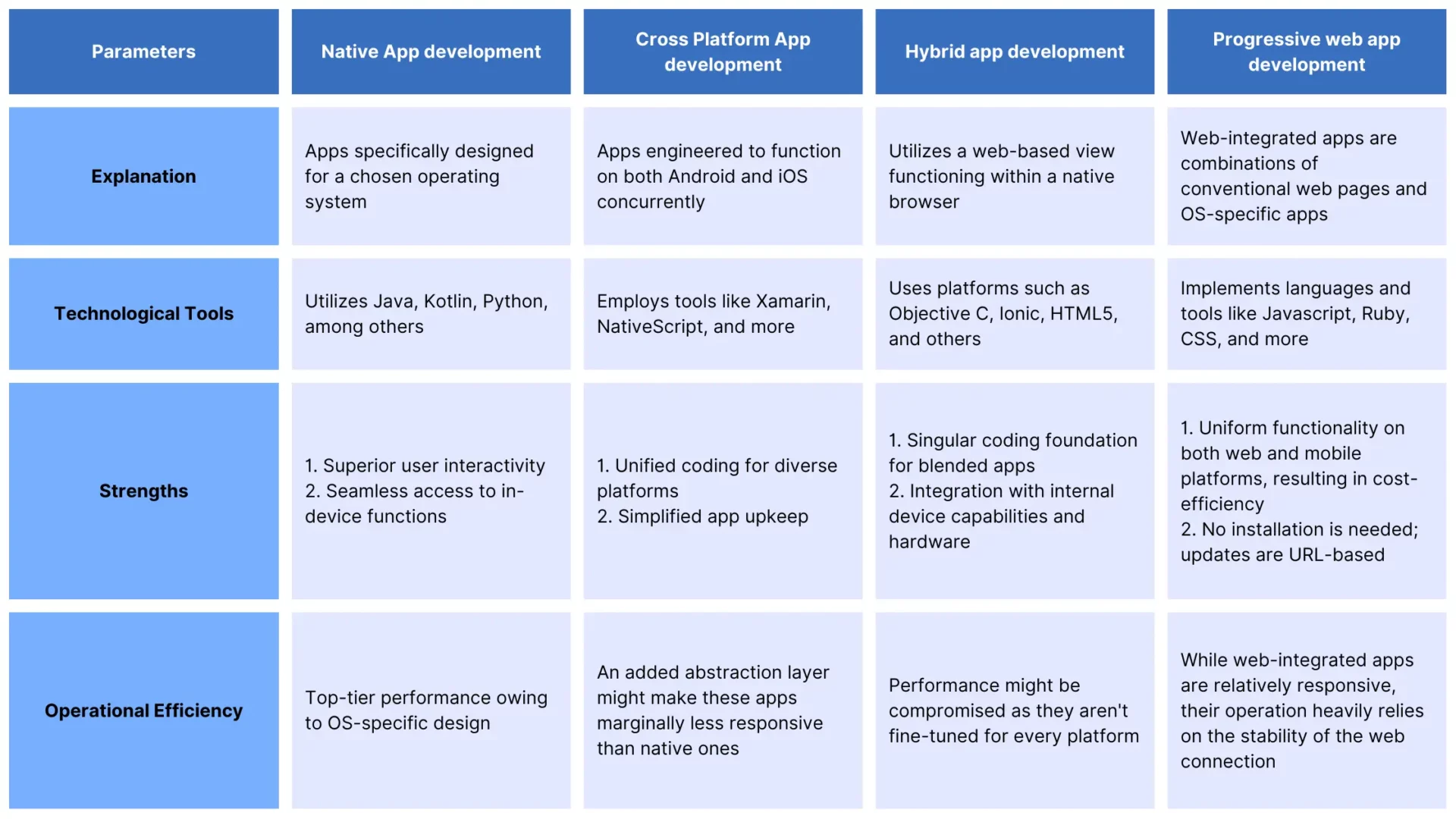Table of Contents
The dynamic mobile app development industry continually evolves with each passing year, driven by technological innovations and changing user preferences. As we eagerly anticipate the arrival of 2024, a host of emerging trends are on the horizon, poised to usher in significant transformations within the app development landscape.
In this comprehensive article, we will delve into these pivotal trends, illuminating their potential impact and implications.

Mobile App Development Trends to Adopt
1. Hyper-Personalization through AI and ML:
With advancements in Artificial Intelligence, apps are moving beyond standard personalization. They’re now leveraging deep learning and user behavior analysis to deliver hyper-personalized content, offering each user a unique and tailored experience. This level of personalization ensures more user engagement and retention. A few features that can be implemented into a mobile app are
- Image recognition
- Face detection
- Text and image classification
- Sentiment recognition and classification
- Speech recognition
- Predictive maintenance
2. Immersive AR:
Augmented Reality (AR) is making waves by providing immersive experiences that seamlessly blend the digital with the physical world. Whether it’s for gaming, shopping, or social interaction, AR-enhanced apps offer users a more engaging and interactive interface, blurring the lines between the virtual and real worlds.
- Gaming: AR gaming is poised to take off in 2024, with titles like Pokémon GO and Minecraft Earth paving the way for more immersive and interactive gaming experiences.
- Shopping: AR is transforming the shopping experience, allowing users to virtually try on clothes, furniture, or makeup before purchasing them. This technology can also enhance in-store shopping, providing customers with product information and navigation assistance.
- Social Interaction: AR is poised to revolutionize social interaction, enabling users to share their AR experiences with friends and family in real-time. This could include virtual tours, shared gaming sessions, or augmented social media filters.
3. IoT & Beyond:
The Internet of Things (IoT) continues to expand, connecting everyday objects to the digital realm. Apps in 2024 will increasingly become the interface for users to interact with their smart homes, wearable devices, and connected vehicles, creating a more integrated digital ecosystem.
- Smart Homes: IoT-enabled smart home devices are becoming increasingly popular, allowing users to remotely control their lighting, thermostats, security systems, and other appliances. Apps will play a central role in managing and monitoring these devices, providing a seamless user experience.
- Wearable Devices: Wearable devices are becoming more sophisticated, tracking fitness data, monitoring health metrics, and even providing contactless payment options. Apps will be crucial for interacting with these devices, providing data visualizations, personalized insights, and actionable recommendations.
- Connected Vehicles: Connected vehicles are paving the way for safer and more convenient driving experiences. Apps will integrate with these vehicles, providing real-time traffic updates, remote diagnostics, and even hands-free entertainment options.
4. On-Demand Apps:
From food delivery to healthcare consultations, on-demand apps are growing in popularity, providing instant services to users who can fulfill their immediate needs with the tap of a button.
- Delivery Services: On-demand food delivery services have become commonplace, and the trend is expanding to other categories, such as grocery delivery, medication delivery, and even pet care services.
- Healthcare Services: Telemedicine and on-demand virtual consultations are making healthcare more accessible, allowing users to connect with doctors, therapists, and other healthcare providers from the comfort of their homes.
- Personalized Services: On-demand apps are becoming increasingly personalized, tailoring their recommendations and services based on individual user preferences and past behavior.
5. Beacon Technology:
Beacon technology is a proximity-based wireless communication method that enables apps to interact with users based on their location. Beacons are small, typically battery-operated devices that transmit signals using Bluetooth Low Energy (BLE) technology. These signals are then detected by nearby smart devices, such as smartphones or tablets, facilitating various location-based actions and interactions.
- Retail: Beacon technology is transforming the retail experience, allowing stores to send personalized notifications to customers as they enter specific aisles or approach certain products. This can enhance customer engagement, provide product information, and even trigger targeted promotions.
- Navigation and Wayfinding: Beacon technology can be used to provide indoor navigation and wayfinding assistance, guiding users through complex environments such as airports, shopping malls, or convention centers.
- Proximity-Based Marketing: Beacon technology can be used to deliver targeted marketing messages to users based on their location, sending them relevant coupons, promotions, or event notifications.
A Real-life Example of beacon technology can be seen in Walmart – Walmart has innovatively integrated beacons within the LED bulbs used in its stores and parking areas. These strategically positioned beacons monitor visitors and send them tailored notifications, including discounts, coupons, promotional offers, product details, and store maps.
6. Voice User Interfaces (VUIs) on the Rise:
Voice-controlled interactions are becoming mainstream, as users increasingly embrace the convenience and accessibility of voice assistants like Alexa, Siri, and Google Assistant. Apps are increasingly integrating with these voice assistants, allowing users to access features hands-free, making tasks more efficient and convenient.
- Voice Search and Navigation: Voice search is becoming the preferred method for finding information and navigating apps. Apps are incorporating voice search capabilities, allowing users to search for content, control features, and even make purchases using their voice.
- Hands-Free Tasks: Voice assistants are enabling hands-free control of various tasks
7. Minimalist Navigation Gestures:
Clean, intuitive navigation is in demand. Users prefer apps with minimalist design and intuitive gestures, reducing cognitive load and enhancing user experience.
- Gesture-Based Navigation: Gestures are becoming the preferred method for navigating apps, as they offer a more natural and intuitive way to interact with the interface.
- Seamless Workflow: Minimalist design principles are being applied to navigation, creating a seamless and effortless user experience.
- Reduced Cognitive Load: By simplifying navigation, apps can reduce the mental effort required for tasks, making them more user-friendly.
8. Micro-Interactions for Personalization:
Micro-interactions are subtle animations or design elements that provide feedback, guide tasks, or enhance user interactions. They can make apps more engaging and user-friendly.
- Feedback and Confirmation: Micro-interactions provide visual feedback for actions, confirming successful tasks and reducing uncertainty.
- Guided User Flow: Micro-interactions can gently guide users through complex tasks, making the experience more intuitive and less error-prone.
- Enhanced Engagement: Micro-interactions can add a touch of delight to common interactions, making apps more enjoyable to use.
9. 5G:
With growing awareness about sustainability, apps are being designed with eco-friendliness in mind. This includes everything from reducing energy consumption to promoting sustainable practices within the app content.

According to IHS Economics, 5G wireless networks are set to unlock a staggering global revenue opportunity of approximately $12.3 trillion, impacting various industries.
10. Predictive analytics:
Utilizing advanced technologies such as machine learning and AI, predictive analytics can anticipate future events based on historical data. Leading tech companies have been harnessing the power of predictive analytics for some time.
Take Netflix as an example; it employs predictive analytics to tailor movie suggestions based on a user’s viewing history.
By 2023, the adoption of predictive analytics is expected to expand across a broader spectrum of mobile apps, becoming more prevalent in mainstream applications. The primary goal will be to elevate the UI/UX within apps, leading to heightened user engagement and retention. This is one of the latest Mobile App Development Trends to improve user experience.
Types of App Development:
Native App Development:
These are apps developed for specific platforms, such as Android or iOS, using platform-specific programming languages. They offer optimal performance but require separate development for each platform.
Cross-Platform App Development:
As mentioned, tools like Flutter and React Native allow developers to build apps for multiple platforms with a single codebase.
Progressive Web Apps (PWAs):
These are web applications that behave like native apps. They’re user-friendly, fast, and can work offline, bridging the gap between web and mobile apps.
Hybrid Apps development:
These apps use a combination of native components and web views to deliver cross-platform compatibility while maintaining native app performance.
Comparison of different app development types:
In conclusion, 2024 is set to be a transformative year for mobile app development. By staying updated with these trends, developers and businesses can position themselves at the forefront of innovation, delivering unparalleled user experiences. Explore HyScaler’s end-to-end app development services to stay ahead of the upcoming mobile app development trend in 2024.

FAQs
Q. What does mobile application development entail?
A. Mobile application development refers to the process of crafting apps specifically designed for mobile devices. These apps can be obtained from app stores, come pre-loaded on devices, or be accessed via mobile browsers.
Q. Why should businesses consider mobile application development?
A. Delving into mobile application development offers businesses various advantages such as:
- Augmenting customer value
- Bolstering client retention rates
- Enhancing customer allegiance
- Gaining a competitive edge
- Boosting operational efficiency
Q. What’s the typical timeframe for app creation?
A. The duration to develop an app usually ranges from three to nine months, contingent on the intricacy of the mobile application development project.
Q. Which mistakes should be avoided during mobile application development?
A. When venturing into mobile application development, it’s prudent to steer clear of:
- Overlooking user interface (UI) essentials
- Skipping the development of a minimum viable product (MVP)
- Not focusing on precise audience targeting
- Neglecting a sound monetization plan
- Overloading the app with excessive features
Q. What will be the emerging Mobile App Development Trends in 2024?
A. Mobile app development trends that are expected to rise in 2024 are :
- Hyper-Personalization through AI and ML
- Immersive AR
- IoT
- Voice User Interfaces (VUIs)
- 5G
- Beacon Technology
- On-demand apps





